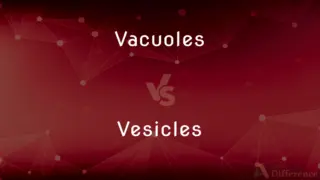Batch Fermentation vs. Continuous Fermentation — What's the Difference?
Edited by Tayyaba Rehman — By Fiza Rafique — Published on January 12, 2024
Batch fermentation is a closed-system process with set duration, while continuous fermentation constantly adds substrates and removes end products.

Difference Between Batch Fermentation and Continuous Fermentation
Table of Contents
ADVERTISEMENT
Key Differences
Batch Fermentation involves growing microorganisms in a closed system where all ingredients are added at the beginning, and the process runs for a fixed period until completion. In Continuous Fermentation, the process is open-ended, with substrates continuously added and products removed simultaneously, allowing for an ongoing process.
In Batch Fermentation, the microorganisms go through a predictable growth curve, including lag, exponential, stationary, and death phases, which can affect product yield. Continuous Fermentation maintains microorganisms in a steady-state or exponential growth phase, potentially resulting in a more consistent product quality.
Batch Fermentation often requires downtime between batches for cleaning and setting up, which can decrease overall productivity. Continuous Fermentation systems are designed to operate indefinitely, significantly reducing downtime and potentially increasing production efficiency.
The conditions within a Batch Fermentation system can change significantly over the course of the fermentation, leading to a variable product. Continuous Fermentation can offer better control over environmental conditions, resulting in more uniform product characteristics.
Batch Fermentation can be advantageous for producing a variety of products in the same equipment with relative ease of changing between different production runs. Continuous Fermentation systems are usually dedicated to a single product due to the complexity and cost of changing operational conditions.
ADVERTISEMENT
Comparison Chart
System Type
Closed, fixed duration
Open, indefinite duration
Process Phases
Goes through lag to death phases
Steady-state exponential phase
Downtime
Required between batches
Minimal to none
Product Consistency
Variable due to phases
More consistent
Suitability for Products
Versatile for multiple products
Best for single, high-demand products
Compare with Definitions
Batch Fermentation
A sequential method where one batch is processed at a time.
The antibiotic was produced through a carefully monitored batch fermentation.
Continuous Fermentation
An uninterrupted production cycle in fermentation industries.
Continuous fermentation ensures there is always beer ready for bottling.
Batch Fermentation
A finite fermentation that proceeds through distinct growth phases.
Each batch fermentation of yogurt takes precisely eight hours to achieve the right tanginess.
Continuous Fermentation
A method that maintains microbial cells in an optimal growth phase.
By using continuous fermentation, the bioreactor maximizes enzyme production.
Batch Fermentation
Intermittent fermentation cycles in a contained environment.
Batch fermentation allowed the winemaker to experiment with different grape varieties.
Continuous Fermentation
A nonstop fermentation process with ongoing input and output.
The ethanol plant uses continuous fermentation to meet constant demand.
Batch Fermentation
A discrete fermentation process with all inputs added at the start.
Our cheese cultures undergo batch fermentation for precise flavor development.
Continuous Fermentation
A process designed for large-scale and consistent product output.
The facility opted for continuous fermentation to streamline sourdough bread production.
Batch Fermentation
A process where microorganisms ferment in a closed vessel for a set period.
The brewery used batch fermentation for their limited-edition ale.
Continuous Fermentation
Fermentation where substrate is added and product removed simultaneously.
Continuous fermentation allows the dairy to produce a steady supply of kefir.
Common Curiosities
Is there downtime in batch fermentation?
Yes, downtime is needed between batches for cleaning and setup.
Is continuous fermentation more efficient than batch fermentation?
It can be more efficient due to reduced downtime and steady-state operation.
How do the growth phases in batch fermentation affect the product?
Different growth phases can lead to variations in product characteristics and yield.
Does continuous fermentation require a larger initial investment?
Generally, yes, due to the complexity of setting up a continuous system.
What is batch fermentation?
Batch fermentation is a discrete fermentation process with a set start and end point.
Can continuous fermentation lead to a more consistent product?
Yes, it maintains cells in a constant growth phase for uniform product quality.
What type of products are best suited for continuous fermentation?
Products with a high and steady demand, like some biofuels and beverages, are well-suited.
Can batch fermentation produce a range of products?
Yes, it's adaptable to various recipes and fermentation profiles.
What is continuous fermentation?
Continuous fermentation is an ongoing process where new substrate is added and product removed constantly.
How does continuous fermentation handle microbial contamination?
It can be more susceptible to contamination, requiring strict control and monitoring.
Why might a company choose batch over continuous fermentation?
Batch fermentation is flexible for making different products with the same equipment.
Can batch fermentation be used for high-volume production?
It can, but it may be less efficient than continuous processes for high-volume products.
How do operators control the fermentation process in batch fermentation?
Operators control the process by monitoring and adjusting parameters at each batch.
What are the advantages of continuous fermentation in the pharmaceutical industry?
It offers a continuous supply of product and can be more cost-effective at scale.
How does product quality compare between batch and continuous fermentation?
Continuous fermentation typically offers more consistent product quality.
Share Your Discovery

Previous Comparison
Liquefied Petroleum Gas vs. Compressed Natural Gas
Next Comparison
Vacuoles vs. VesiclesAuthor Spotlight
Written by
Fiza RafiqueFiza Rafique is a skilled content writer at AskDifference.com, where she meticulously refines and enhances written pieces. Drawing from her vast editorial expertise, Fiza ensures clarity, accuracy, and precision in every article. Passionate about language, she continually seeks to elevate the quality of content for readers worldwide.
Edited by
Tayyaba RehmanTayyaba Rehman is a distinguished writer, currently serving as a primary contributor to askdifference.com. As a researcher in semantics and etymology, Tayyaba's passion for the complexity of languages and their distinctions has found a perfect home on the platform. Tayyaba delves into the intricacies of language, distinguishing between commonly confused words and phrases, thereby providing clarity for readers worldwide.












































